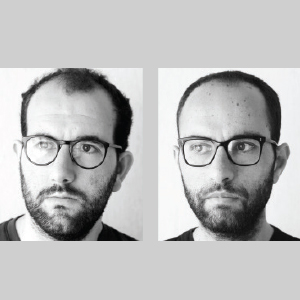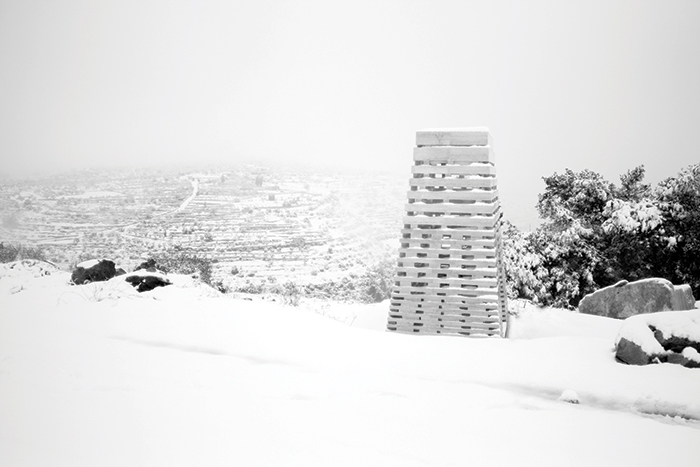
The edge is where potentialities are revealed: living on the edge, one has to put into motion everything possible in order to persevere.
On the Edge is a story about making architecture in Palestine told through the specific case of The Stonesourcing Space project: A stone pavilion which adapts traditional techniques to the imperatives of resistance within the framework of the Palestinian public space, The Stonesourcing Space is a project that was designed, fabricated, and implemented in 2013 by Scales, the research department of AAU Anastas. The exhibition on Manger Square in Bethlehem was motivated by the urgency of standing up to a misuse of stone and an urbanism that is increasingly taken out of its context in Palestinian cities, while it aims to set in motion a thinking process that links stone construction techniques to the urban morphology of Palestinian cities. The Stonesourcing Space intends to foster a strategic awareness for new visions of urban morphologies.
As such, The Stonesourcing Space is a permanent, ongoing project that presents an on-the-edge process of making architecture in Palestine. It visualizes an essential relation to the contested geographical and political edge of Palestinian reality and reacts to architectural concerns – on a research level as well as on a territorial scale. The Stonesourcing Space is strengthened by every on-the-edge situation by offering immediate tangible solutions.
Chora
Chora in ancient Greek refers to a definite location that is either occupied or can be occupied by something, denoting a void or a potential.
Historically, Palestinian cities have been built with a relationship to nature – to vast expanses of countryside landscape. The nucleus of a city, managed by its inhabitants, was considered only a small part of the city which was defined mainly by its surrounding landscape. The only constructions found outside the dense nuclei were the manateers, countryside shelters used to mark territory and to signal property. The Ottoman Empire and the British Mandate introduced urban regulations that transformed the use of space from appropriation to attribution. The territorial restrictions of the Israeli occupation increased the tendency of containing the use of space; and consequently, today the layout of cities is muddled. A physical limit is imposed by the Separation Wall. These complex territorial devices transform Palestinian cities into territories whose urban spread has a visual horizon drawn by the Wall’s path. Additionally, in order to protect one’s land, one must prove that it is inhabited. Thus, the temptation of the urban filling of an enclave is a natural reaction and Palestinian cities have adopted a new scale: less defined, less dense, less concentrated, and their construction spreads without a real master plan. Through change in the use of space, a shift has taken place, moving from a dense urbanism emptying its landscape surroundings to the temptation of filling up the space on the cities’ edges.
♦ Originally produced on Manger Square in 2013, The Stonesourcing Space’s special features allow the structure to legally persevere in Area C. It can be viewed on the edge of Makhrour Valley, near Hosh Jasmin, Bethlehem. In August 2015 the project was featured at The Voices of Sirens, an exhibition at the Little Constellation Network for Contemporary Art in Gibraltar.
Since all geographical spaces on the edges of Palestinian cities are threatened by expropriation, The Stonesourcing Space is implemented in Wadi Makhrour, at the western limit of Bethlehem, in the same way in which the ancient manateers had the function of alerting wayfarers to the fact that a piece of land was privately owned. Wadi Makhrour is situated in Area C, defined by the Oslo Accords as Palestinian property, yet under Israeli control – and as such it is constantly threatened by colonization and expropriation. All constructions on the geographical edge of Bethlehem are categorically forbidden.
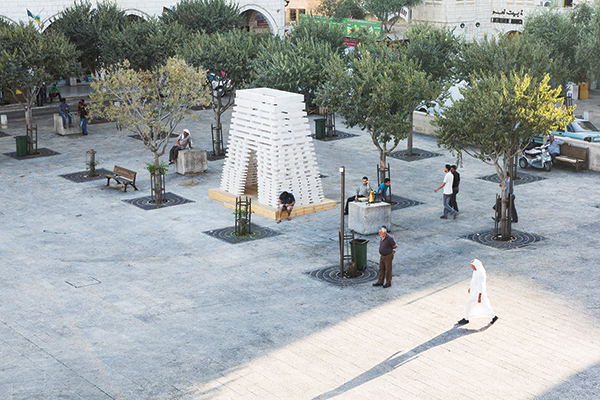
Without spoiling the landscape or condemning the city’s development on a long term basis, The Stonesourcing Space’s goal is to provide an answer to the need of land consumption in times of war and to mark property as an act of resistance to the Wall’s path. Since the city’s limit has been erased over time through numerous, often unfathomable political separation policies, The Stonesourcing Space goes beyond the power-driven practice of dominating space and puts back nature as part of the urbanism process. The city extends to the limit beyond which any going further would be topographically destroying nature: the edge of the valley.
From a viewpoint that considers political context, The Stonesourcing Space is implemented on a territory that features an exhaustive sample of the space-related complexities that exist in Palestine: it overlooks road 60 – used by settlers to commute from settlements to Jerusalem; it is located on a hill under which road 60 becomes a tunnel; it is only a twenty-minute walking distance away from the city center of Beit Jala; it shares the valley with the Palestinian city of Battir, inscribed on the UNESCO World Heritage list; and it is overlooked by Har Gilo, a settlement located on the highest hill in the area. The Stonesourcing Space is built from stones that weigh five tons, but it has no roof. Thus, it is indestructible – at least according to the political meaning of space use and due to the law of the roof.
Let us explain: In 1993 the Oslo accords divided the West Bank into three areas, each with a different status that denotes the amount of self-government Palestinians are allowed to exert through the Palestinian Authority. This situation was intended to be temporary, until a Final Status Agreement would be established in 1999. Area A includes eight Palestinian cities and their surrounding areas (Nablus, Jenin, Tulkarem, Qalqilya, Ramallah, Bethlehem, Jericho and eighty percent of Hebron), exempting Israeli settlements. Entry into this area is forbidden to all Israeli citizens. Area B is under Palestinian civil control and joint Israeli-Palestinian security control. Area C is under full Israeli civil and security control. Seventy percent of this area is defined as within settler municipal boundaries where permits for development are denied to Palestinians. Constructions are only accepted if they have neither roof nor foundations. The Stonesourcing Space does not have a roof – and yet it weighs more than 5 tons of stone!
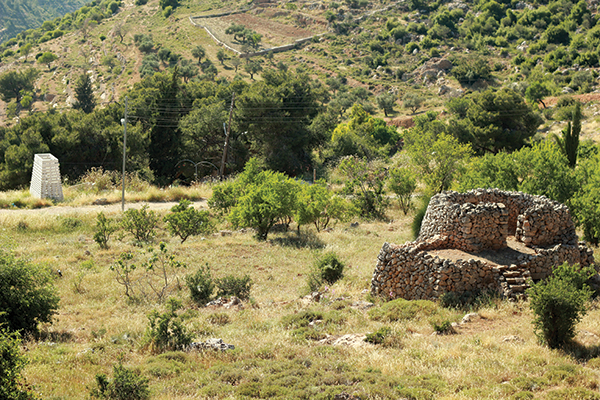
Kairos
Kairos in ancient Greek refers to an instant of time, experienced as unmeasured, occurring at the intersection of natural events and human wisdom, and defined by the opportunity that this moment carries.
Construction started on a hot summer day in August after the wedding of Abu Awwad’s daughter. Although all documents had been ready in mid-July, most stone factories in the region of Bethlehem had refused to cut the 859 stones, mainly because it broke the production rhythm of the standardized stone products, usually the size of 2,3 or 5cm. However Abu Awwad’s stone business, whose backyard has been cut in two parts by the Separation Wall, did accept the challenge. His family has been in the stone craftsmanship for several generations, and he was supportive of standing up to the recent misuse and standardization of stone.
On a Saturday afternoon, drinking Arabic coffee in his workshop, Abu Awwad promised to deliver the stones – all of them – next Tuesday, adding that he could not deliver them earlier because his daughter’s wedding was on Monday. We had found a partner who was at least as convinced as we were of the necessity of rebelling against the current use of stone! However, for Abu Awwad it was also a way of paying a tribute to his ancestors and their love of stone.
The misuse of stone is not typical or methodological: stone cladding is used in the whole world. But in Palestine stone use is particularly misused due to a neglect of our heritage of construction methods, a heritage built over time. Unfortunately, in the last century, stone-construction know-how didn’t evolve. Our generation may be the one who will completely forget those techniques – or it may not.
Not only does The Stonesourcing Space stand up to the disappearance of historical know-how, it aims at enriching it by introducing new construction techniques based on novel design simulation and fabrication processes. Although on the edge of vanishing, some aspects of stone construction heritage remain profoundly settled in Palestinian culture. Palestinian quarries refuse to use bad quality stone, almost by arrogance, even though mediocre quality stone blocks – i.e. poor mechanical properties – satisfy the requirements for stone cladding construction as used today in all buildings. Instead, they only accept the blocks with the best characteristics, leaving the mediocre quality to the Israeli market. In Palestinian imagination, time has inscribed a trace of what stone must be, a trace that even occupation cannot destroy.
The Stonesourcing Space intends to be part of the existing landscape. The durability of the material and its resistance to climate influences increase its ability to adapt to the landscape and, on a long term basis, even to merge with it. Just as manateers became an essential part of Palestinian landscape, The Stonesourcing Space mixes material use and morphology with the goal of bringing back nature as a criterion for urbanism.
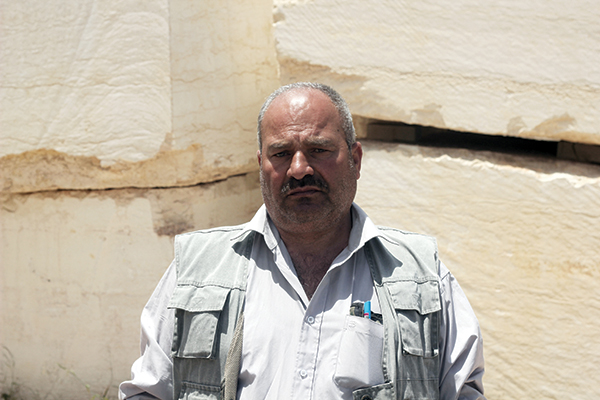
Kinesis
Kinesis in ancient Greek refers to motion.
After its construction and exhibition on Manger Square, The Stonesourcing Space had to move. On moving day the square was crowded and bets were on: will the pavilion be successfully dismantled or not. Abu Wadi’, the best-known trailer driver was on the square; his entire reputation was at stake. But taking the pavilion from the square was the easy task. Moving it to Makhrour Valley was difficult, and implementing it in Area C seemed impossible.
On a Friday evening the pavilion was dismantled. A special convoy was organized to move from Manger Square to Makhrour Valley: the trailer was preceded and followed by municipal police cars and didn’t exceed 15 km/h in speed. There were difficulties of topography to overcome in reaching the western limit of Bethlehem, passing through 800 m of declivity, and additional difficulties in settling down the pavilion in Area C, where all construction is forbidden by the Israeli authorities. On a Friday night, we knew we would avoid the latter difficulty – at least until the next day.
Techne
Techne in ancient Greek, refers to craftsmanship. Urbanism is a way of crafting the citizens of a community.
Before and during the Ottoman Empire, urban development was influenced by three factors: harat (’big families’ to which every inhabitant was linked), hosh (a common shared space in the heart of a series of houses), and the typical city surroundings of olive orchards and terraced landscapes. At that time, urban strategies were regulated between the moukhtar (chiefs) of each hara. This self-managed urbanism, whose successful operation would fulfil many of today’s western criteria of a successful city, has progressively been disappearing. The dense nucleus is no longer as much a center of interest as the surroundings where cities boom. Palestinian cities today have very complex boundaries. The British mandate put in place urban planning. Power rather than nature took precedence and in response, Palestinian cities have broken with their domestic scale. Their boundaries are being dictated by the Separation Wall, and the unstable political situation is leading to a lack of trust in public space.
The Stonesourcing Space addresses the question of public space in the city of Bethlehem. The stone structure takes a rebellious stand against current construction techniques and poor intellectual research investment in the only locally-available independent and abundant Palestinian construction material. As a place where expression, debate, and innovation are possible, public space is both the locus of counter powers and the necessary binder of the state. It is the meeting place of architects, engineers, mayors, citizens, bricklayers, historians, and many more. And while in the past public space was inherent to Palestinian urbanism, under modern circumstances there has been a clear break-off with public space. The Stonesourcing Space stands for a reconciliation of Palestinians with their public spaces.
The Stonesourcing Space on Manger Square aimed to embody urban social power and artisanal skills and to help build an inclusive city.
» Yousef Anastas is an architect and engineer, principal at AAU ANASTAS.
He is currently leading AAU Anastas’ research department, SCALES, a research laboratory that aims to consistently link together scales that are otherwise opposed.
He is a co-founder of Local Industries and can be reached at yousef@aauanastas.com.
» Elias Anastas is an architect, principal at AAU ANASTAS.
He is a co-founder of Local Industries, a project born from the desire to put direct collaboration with local artisans at the heart of the process and to look for ways to minimize energy consumption for the creation and production of industrial design. Elias can be reached at elias@aauanastas.com.

